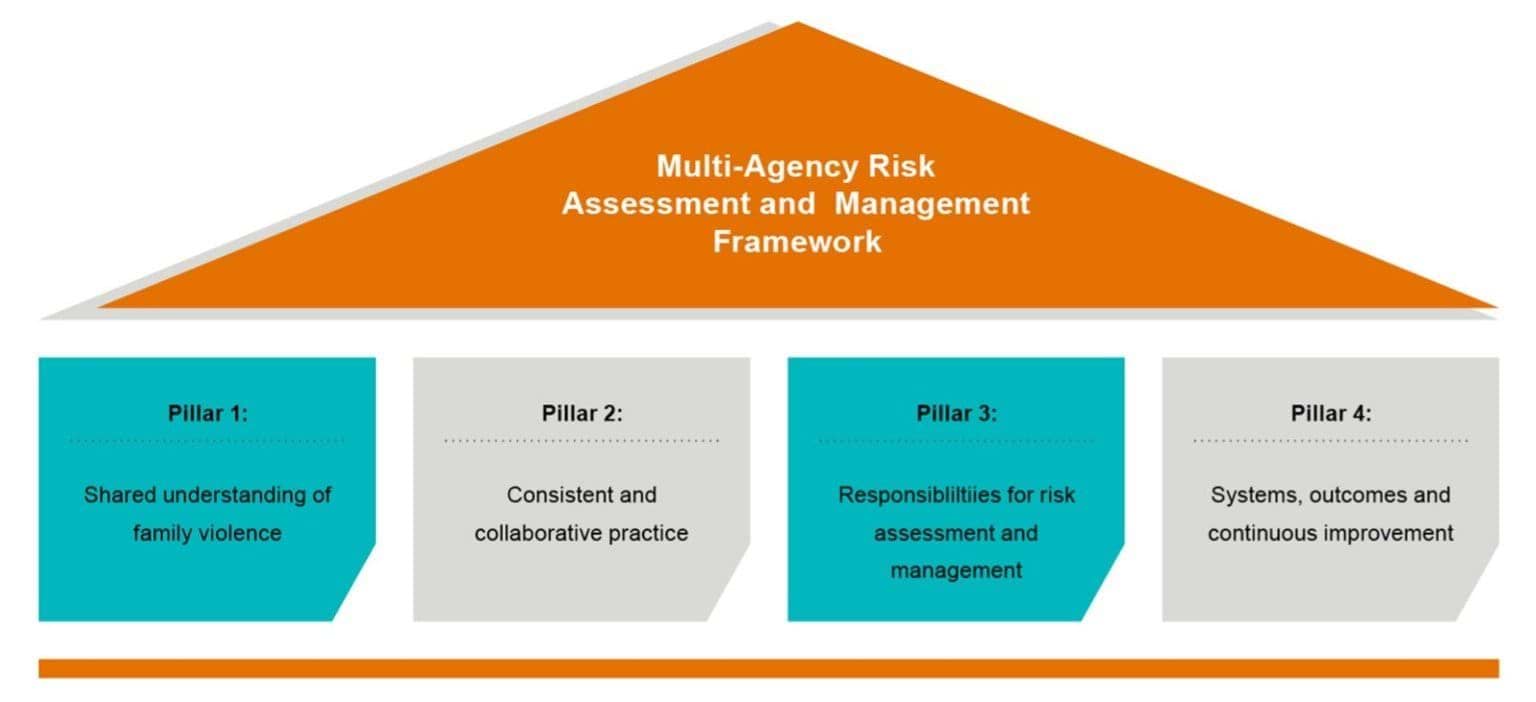It establishes the architecture and accountability mechanisms of a system-wide approach to, and shared responsibility for, responding to the family violence risk that perpetrators cause.
These elements are set at the organisational level.
They provide the authorising environment, and enablers of practice, for individual professionals and services within organisations in their work with adult and child victim survivors and adult perpetrators.
4.1 Key aspects of the MARAM Framework
- Part 11 of the Family Violence Protection Act 2008 (FVPA) establishes the authorising environment for the MARAM Framework by creating a legislative instrument and enabling prescription of organisations through regulation.
- The Framework’s legislative instrument describes the four pillars, the requirements for alignment, the guiding principles, the 10 Responsibilities for practice, and the evidence-based risk factors.
- ‘Framework organisations’ and ‘section 191 agencies’ are prescribed under the Family Violence Protection (Information Sharing and Risk Management) Regulations 2018. Prescribed organisations are required to progressively align their policies, procedures, practice guidance and tools with the Framework legislative instrument.
- The MARAM Framework complements and provides further information about the legislative instrument.
4.2 Information Sharing Schemes
The Family Violence Information Sharing Scheme is a key enabler of the MARAM Framework and associated Practice Guides.
- Part 5A of the FVPA establishes the Family Violence Information Sharing Scheme, which allows prescribed organisations to share information relevant to family violence risk assessment and management practice, in relation to victim survivor and perpetrator-focused Responsibilities 5 and 6.
- The Family Violence Information Sharing Scheme Guidelines outline how information is to be shared in practice.
The Child Information Sharing Scheme further assists in responding to safety and wellbeing for children.
- Part 6A of the Child Wellbeing and Safety Act 2005 (Vic.) establishes the Child Information Sharing Scheme, which allows the sharing of information for the purpose of promoting a child’s wellbeing or safety, including but not limited to the context of family violence. This may include information relating to a child’s stabilisation and recovery from family violence, reflected in the protective factors outlined in victim survivor–focused Responsibility 3.
Other complementary information sharing and reporting obligations continue to apply.
- The Information Sharing Schemes do not affect the reporting obligations created under other legislation, such as mandatory reporting under the Children, Youth and Families Act 2005 (Vic.).
- The Information Sharing Schemes complement and build on existing permissions held by organisations and services to share information under other laws, such as the Privacy and Data Protection Act 2014 (Vic.), the Health Records Act 2001 (Vic.), and the Children Youth and Families Act 2005 (Vic.).
4.3 Policy and practice direction
The MARAM Framework and Practice Guides, including this Foundation Knowledge Guide, provide policy and practice direction.
They are for professionals and leaders working within prescribed organisations and services that undertake family violence risk assessment and risk management practice in Victoria.
Leaders of prescribed organisations make decisions at the organisational level to identify the practice responsibilities for their professionals and services and ensure they are applied in practice.
Professionals need to have a clear understanding of their own role in relation to responding to family violence within the broader service system.
This will help to determine which level of risk identification, assessment and management applies to your role and which MARAM Responsibilities and Practice Guides are relevant to your work.
More detail on the legislative, policy and practice environment is described in ‘Part B: System architecture and accountability’ of the MARAM Framework.
4.4 The MARAM Framework Pillars
The MARAM Framework is structured around four conceptual pillars. Organisations will align their risk assessment and management policies, procedures, practice guidelines and tools with these pillars.
Each pillar has its own objective and requirement for alignment. The objectives of the pillars are outlined below.
4.4.1 Pillar 1: Shared understanding of family violence
Everyone working in the service system, regardless of their role, needs to have a shared understanding of family violence and perpetrator behaviour, including its drivers, presentation, prevalence and impacts.
This enables a consistent approach to risk assessment and management across the service system and helps keep perpetrators in view and accountable and victim survivors safe.
Pillar 1 creates a shared understanding of:
- what constitutes family violence, including common perpetrator actions, behaviours and patterns of coercion and control
- the causes of family violence, particularly community attitudes about gender, and other forms of inequality and discrimination
- established evidence-based risk factors, particularly those that relate to increased likelihood and severity of family violence.
4.4.2 Pillar 2: Consistent and collaborative practice
Pillar 2 builds on the shared understanding of family violence created in Pillar 1 by developing consistent and collaborative practice for family violence risk assessment and management across different professional roles and sectors.
You should use Structured Professional Judgement in your role to assess the level or ‘seriousness’ of risk, informed by:
- the victim survivor’s self-assessed level of risk
- evidence-based risk factors (using the relevant assessment tool)
- sharing information with other professionals as appropriate to help inform professional judgement and decision-making
- using an intersectional analysis when applying professional judgement to determine the level of risk.
4.4.3 Pillar 3: Responsibilities for risk assessment and management
Pillar 3 builds on Pillars 1 and 2. It describes responsibilities for facilitating family violence risk assessment and management.
It provides advice on how professionals and organisations define their responsibilities to support consistency of practice across the service system, and to clarify the expectations of different organisations, professionals and service users.
4.4.4 Pillar 4: Systems, outcomes and continuous improvement
Pillar 4 outlines how organisational leaders and governance bodies contribute to, and engage with, system-wide data collection, monitoring and evaluation of tools, processes and implementation of the Framework.
This pillar describes how aggregated data will support better understanding of service user outcomes and systemic practice issues, and it will assist in continuous practice improvement.
This information will also feed into the legislated five-yearly reviews of the Framework to ensure it continues to reflect evidence-based best practice.
Updated
